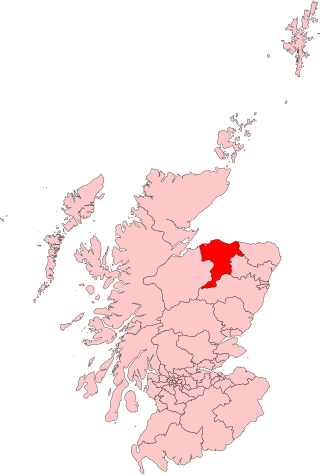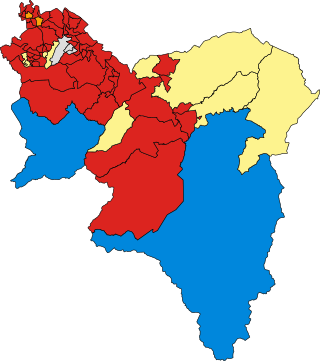
Moray is one of the 32 council areas of Scotland. It lies in the north-east of the country, with a coastline on the Moray Firth, and borders the council areas of Aberdeenshire and Highland. Its council is based in Elgin, the area's largest town. The main towns are generally in the north of the area on the coastal plain. The south of the area is more sparsely populated and mountainous, including part of the Cairngorms National Park.

Moray was a county constituency of the House of Commons of the Parliament of the United Kingdom. It elected one Member of Parliament (MP) by the first past the post system of election.
The East Riding of Yorkshire is a unitary authority in the ceremonial county of the East Riding of Yorkshire, England. It was created on 1 April 1996 replacing East Yorkshire, East Yorkshire Borough of Beverley, Holderness, part of Boothferry and Humberside County Council.

Elections to Aberdeenshire Council were held on 3 May 2007 the same day as the other Scottish local government elections and the Scottish Parliament general election. The election was the first one using 19 new wards created as a result of the Local Governance (Scotland) Act 2004, each ward would elect three or four councillors using the single transferable vote system form of proportional representation. The new wards replaced 68 single-member wards which used the plurality system of election.

The 2007Moray Council Council election was held on 3 May 2007, the same day as the Scottish Parliament election. The election was the first using the eight new wards created under the Local Governance (Scotland) Act 2004. 26 councillors were elected. Each ward elected either 3 or 4 members, using the STV electoral system. Previously there were single-member wards which used the first past the post electoral system.

Elections to South Lanarkshire Council took place on 3 May 2007 on the same day as the 31 other Scottish local government elections.
Elections to North Ayrshire Council were held on 3 May 2007, the same day as the 31 other Scottish local government elections and the Scottish Parliament elections. The election was the first one using eight new wards created as a result of the Local Governance (Scotland) Act 2004, each ward will elect three or four councillors using the single transferable vote system form of proportional representation. The new wards replaced the 30 single-member wards which used the plurality system of election.
Elections to East Ayrshire Council were held on 3 May 2007, the same day as the other Scottish local government elections and the Scottish Parliament general election. The election was the first one using nine new wards created as a result of the Local Governance (Scotland) Act 2004, each ward will elect three or four councillors using the single transferable vote system form of proportional representation. The new wards replace 32 single-member wards which used the plurality system of election.

Elections to South Lanarkshire Council were held on 1 May 2003, the same day as the 31 other local government elections in Scotland and elections to the Scottish Parliament. This was the third election since the council's creation in 1995 and the last election to use first-past-the-post voting.

The 2007 South Ayrshire Council election took place on 3 May 2007 on the same day as the 31 other Scottish local government elections and elections to the Scottish Parliament.
Elections to East Ayrshire Council were held on 1 May 2003, the same day as the 31 other local government elections in Scotland and elections to the Scottish Parliament. This was the third election since the council's creation in 1995 and the last election to use first-past-the-post voting.

The 2012 Moray Council election was held on 3 May 2012, the same day as the other 31 local authorities in Scotland. The election used the eight wards created under the Local Governance (Scotland) Act 2004, with 26 councillors being elected. Each ward elected either 3 or 4 members, using the STV electoral system.
The 2012 North Ayrshire Council election took place on 3 May 2012 to elect members of North Ayrshire Council. The election used the eight wards created as a result of the Local Governance (Scotland) Act 2004, with each ward electing three or four councillors using the single transferable vote system form of proportional representation, with 30 Councillors being elected.

The 2017 Moray Council election was held on Thursday 4 May 2017, on the same day as the 31 other local authorities in Scotland. It was the third successive Local Council election to run under the STV Electoral System. The election used the eight wards created under the Local Governance (Scotland) Act 2004, with 26 Councillors being elected. Each ward elected either 3 or 4 members, using the STV electoral system - a form of proportional representation.

East Kilbride West is one of the 20 electoral wards of South Lanarkshire Council. Created in 2007, the ward elects three councillors using the single transferable vote electoral system and covers an area with a population of 13,737 people.
Elections to The Highland Council were held on 5 May 2022, the same day as the 31 other Scottish local government elections. As with other Scottish council elections, it was held using single transferable vote (STV) – a form of proportional representation – in which multiple candidates are elected in each ward and voters rank candidates in order of preference.

The 2022 Moray Council election was held on 5 May 2022, on the same day as the 31 other local authorities in Scotland. The election used the eight wards created under the Local Governance (Scotland) Act 2004, with 26 Councillors elected. Each ward elects either 3 or 4 members, using the STV electoral system - a form of proportional representation.

The 2022 Dundee City Council election took place on 5 May 2022, the same day as the 31 other Scottish local government elections. Each ward elected three or four councillors using the single transferable vote system, a form of proportional representation used since the 2007 election and according to the Local Governance (Scotland) Act 2004.

Elections to Aberdeenshire Council took place on Thursday 5 May 2022 on the same day as the 31 other Scottish local government elections. As with other Scottish council elections, it was held using single transferable vote (STV) – a form of proportional representation – in which multiple candidates are elected in each ward and voters rank candidates in order of preference.
Elections to the Aberdeenshire Council were held on 1 May 2003, the same day as the other Scottish local government elections and the Scottish Parliament general election. This was the last election to use the first-past-the-post voting system across 68 single member wards.














